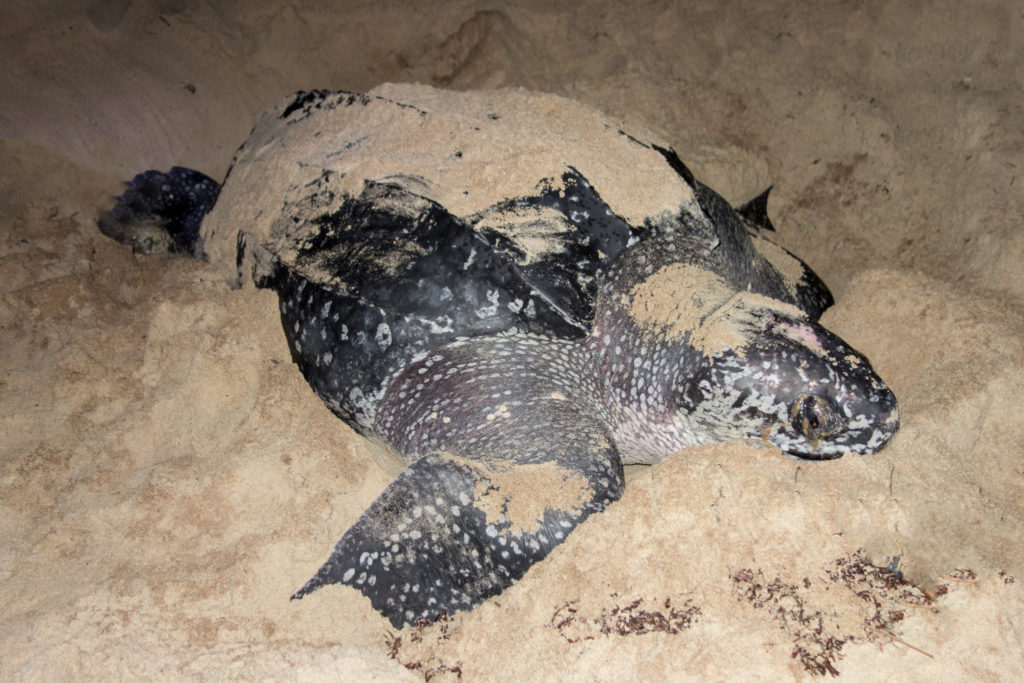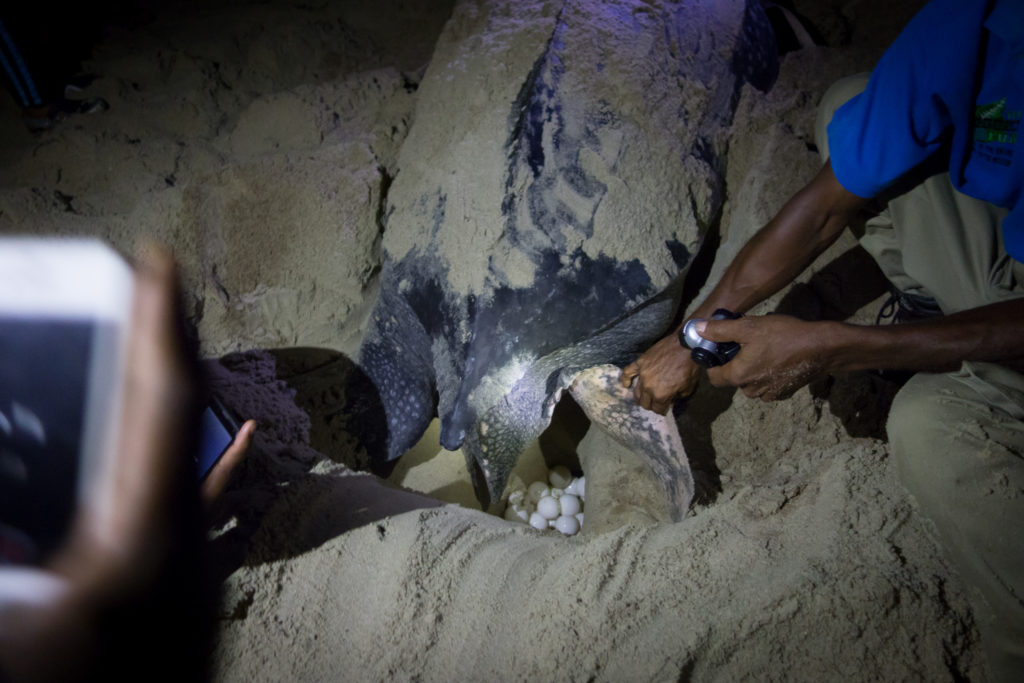The magic of Trinidad’s gentle giants: leatherbacks ashore.
Light from a waning crescent moon barely caressed the landscape. Stars shone, remnants of histories long past, scattering across the heavens like angel dust. Sand, simultaneously soft and coarse, rubbed between my toes, sparking iridescent hues of blue and green, as soft sea breeze whipped around me. Here I was, once more, to share the beach with dinosaurs.
MAGIC AMONG US
The northern and eastern beaches of Trinidad are something special. Most of the time their uniqueness is simply a matter of geography; in some places an undulating landscape of rocks giving way to a coast, in others, long stretches of soft, pale sand and translucent waters, obscured by a churning undertow. On their worst days, these are magical places in their own right. Traveling to resort locales favoured for 3S tourism (sun, sand, and sea), one rarely encounters coves as magnificent as those of Maracas, Las Cuevas, or Tyrico Bay, where beaches are set inward against lush green mountainscapes. Those accustomed to traveling to resort destinations against a backdrop of poverty will note that the beaches in Trinidad are not what they’re accustomed to; Maracas Bay presents a co-mingling of tourists and locals alike, with nothing to segregate tourists “for their safety”, or obscure the realities of Trinidad via any illusory façades. While not necessarily unique (my experience of Caribbean tourism is not extensive), this does set Trinidad and Tobago apart from other island destinations, where international tourists are often confined to the “safety” of gated resorts. There is a certain freedom in this, experiencing the realities of Trinidadian beaches as they are. There is also likely an added air of danger, but born as a Trinidadian as I am, “passing as” means I am less likely to experience the same levels of threat to my person as a tourist that stands out. I can blend into the background, so to speak, so long as I don’t attempt verbal negotiation, and this perhaps gives me a little more freedom in that regard. My accent marking me as a tourist, however, also gives me a different sort of privilege (but that is the subject of another discussion).
On the night in question, I accompanied a small group of local friends to the East Coast of Trinidad to visit Matura Beach. March to September brings a different kind of magic to the shores of the islands as it is then that giant leatherback turtles, on return from their international migratory routes, haul themselves ashore in order to nest. Trinidad’s northern and eastern coasts play an integral role in the international health of turtle populations, primarily the leatherback turtle which is the prominent draw for most tourists, local and international alike. However, five species of turtle are known to nest on the islands’ shores including: Leatherbacks, Hawksbills, Green turtles, Olive Ridleys, and Loggerheads.

“The trance”.
Nesting Leatherback in the process of laying eggs.
While Hawksbills and Green Turtles have been known to appear later in the season, our guide Francis noted that Olive Ridleys and Loggerheads, once common, had not been seen at Matura for at least two years. One can speculate that changing climates and ocean currents, as well as threats to turtles across the globe, have played a prominent role in affecting their nesting behaviours. This suggests yet another reason as to why careful attention needs to be paid to their conservation, and to the maintenance and preservation of their nesting sites.
Turtle Tourism
Nature Seekers at Matura is a volunteer-run organization established in 1990 that has utilized the power of “turtle tourism” to help educate the public as to the dangers facing turtles in the Caribbean region. Leatherbacks, for example, exhibit long migratory routes, from destinations as far as the Eastern Coast of Canada, before coming ashore in the Caribbean to lay clutches of eggs. Despite this long and perilous journey, one of the most significant threats to turtle populations worldwide has been poaching (illegal or otherwise) to support the bushmeat trade. In 1990, turtle poaching stood at an approximate rate of 30% per night at Matura Beach, a significant impact on the nesting population that visited the islands each year. Through substantive work with volunteers, many of whom are locals in the Matura community, Nature Seekers has, by their estimation, reduced turtle poaching in the area to zero, with strict enforcement and support from local police. While their work was once challenged by locals in Matura, many of whom were historically dependent upon the bushmeat trade, the community has long seen the benefits of keeping their turtle populations alive and healthy, with many locals now offering bed and breakfast options or otherwise capitalizing on tourism in the region. Volunteers run turtle watching and turtle tagging tours on the beaches every night, showcasing the spectacle of egg-laying and educating the public as to the threats which challenge the longevity of turtle lives. It should be noted however that although permits from Trinidad’s Forestry Division are required for access to many beaches across Trinidad during nesting season, little in the way of tracking tourists occurs (from my observation) and turtle deaths are still occurring in other parts of the island and throughout the Caribbean region.
My own opinion of turtle tourism is somewhat mixed. As an environmentalist, I am in awe every time I come across one of these gentle giants, particularly when I am privileged enough to bear witness to the spectacle of their nesting. There is something incredibly humbling about being in the presence of creatures, some as large as 8 feet in length, who have roamed since the dinosaurs, giving birth beneath an ancient sky. This is one of the primary reasons I am always startled to hear that Trinidadian citizens are not more appreciative of the magic at their doorstep. Many people in my own family have never borne witness to turtle nesting and suggestions that they do so are often met with mixed interest. At the same time, I am always skeptical of tourism that engages animals in ways that might potentially be detrimental to their health. While this type of tourism is, in many ways, beneficial, providing education and funding for a community and providing them with alternative livelihoods to hunting, in other well established ecotourism markets such as Costa Rica, animal-based ecotourism has sometimes come at the expense of animals (Malkin and Villegas, 2015) . It is crucial, therefore, that we consider the development of tourism initiatives in a holistic sense. The work of Nature Seekers is, no doubt, worthy of accolades as it stands as a great example of the potential of ecotourism initiatives both within and beyond Trinidad’s borders. At the same time, let us not forget the primary objective: Nature above all else.

Our guide examines the clutch after recording her measurements and checking her identification tags.
Some random turtle facts:
- Sea turtles process saltwater. Due to their heavy intake of jellyfish, they also consume a great deal of salt, much of which must be excreted. This is released in the form of tears, often observable during the laying process. There is some evidence to suggest that these thick tear secretions also help to protect turtle eyes from sand.
- The leatherback is the largest of the sea turtles. ranging in approximate size from six to nine feet in length. Unlike their contemporaries, they are the only turtle species to be comprised of a soft, leathery skin, instead of a hard shell. The skin stretches across a series of bony plates, which leaves leatherbacks relatively soft compared to their counterparts. Upon death, the entirety of the leatherback is reduced to dust.
- Turtles are extremely sensitive to most wavelengths of light and will use light to determine whether they are approaching or departing from shore. Testing has determined that red light is somewhat less problematic and for this reason ecologically sensitive guides will use red lamps to guide visitors to nesting areas. White light signals to turtles that they are approaching water and can disorient turtles who are coming ashore to nest. The exception to this is during the process of egg laying (after nest excavation is complete). At this time it is speculated that turtles go into a “trance” and will not abandon their nest, at which time lights are permissible. (I am, obviously, somewhat skeptical about this, and I am often wary of nature photography that intrudes on animal spaces. If you are in such a situation, please do follow the instruction of your guides for the safety of the animals involved.)
- Female sea turtles engage in “sperm storage”, keeping viable semen from several males on hand for many months after mating. She is thus able to fertilize several clutches of eggs over the course of a nesting season, without bothering to mate again, and this helps assist in situations where she is unable to successfully mate during a season. (Might be why male sea turtles take it when they can get it and why sea turtles copulate for hours on end…!)
- With the exception of Kemp’s Ridley, female sea turtles at sexual maturity do not nest every year. This means that turtles tracked on beaches will not return for another 2-4 years (potentially), if at all. Turtles at Matura are tagged with physical tags and microchips, ensuring that their identification can be made anywhere in the world, with or without access to scanning equipment.
References
Malkin, E., & Villegas, P. (2015, September 18). Tourists Thwart Turtles from Nesting in Costa Rica. The New York Times. Retrieved from http://www.nytimes.com/2015/09/19/world/americas/tourists-thwart-turtles-from-nesting-in-costa-rica.html
Taking photos, leaving footsteps in the sand…








Leave a reply